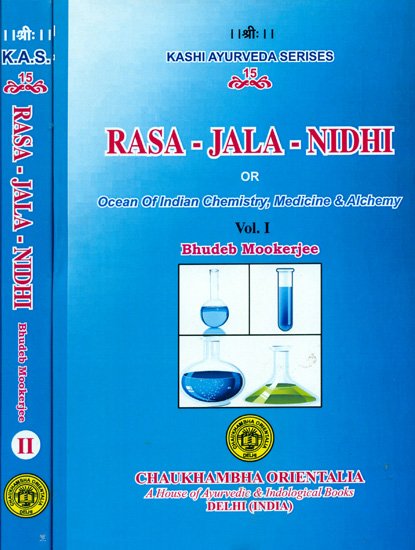Rasa Jala Nidhi, vol 3: Metals, Gems and other substances
by Bhudeb Mookerjee | 1938 | 47,185 words | ISBN-10: 8170305829 | ISBN-13: 9788170305828
This third volume of the Rasa-jala-nidhi deals with purification techniques of the Seven Metals (sapta-dhatu) and various Gems (ratna). It also deals with substances such as Alkalis (kshara), Salts (lavana), Poisions (visha) and Semi-poisions (upavisha) as well as various alcholic liquors. The Rasa-jala-nidhi (“the ocean of Iatrochemistry, or, che...
Part 2 - Purification of gold
(note: the term “purification” of a metal, as used in this book, does not mean to purify it physically, but to purify it medicinally. No metal which is physically impure should be used in medicines, except, of course, the mixed metals.)
First process.
Pure mineral gold which has got only 14 colours, becomes absolutely pure and assumes 16 colours, if it is mixed with pansu lavana (or salt prepared from ashes of plantain, etc.), and heated over charcoal fire for one and half hour.
Second process.
Leaves of gold, silver, brass, copper, and iron are purified, if they are heated overfire and immersed, while still hot, into oil, butter milk, milk, kanji, and decoction of kulattha, for seven times each, separately.
The term “purification” of a metal, as used in this book, does not mean to purify it physically, but to purify it medicinally, Ho metal which is physically impure should be used in medicines, except, of course, the mixed metals.
Third process.
All sorts of metals are purified, if they are heated for seven times, and immersed each time in the juice of the root of a banana plant.
Fourth process.
Gold is purified, if subjected to puta with burnt mud and salt, after having been previously subjected to bhavana for five times with mud and juice of matulunga.
Fifth process.
The pancha-mrittika (i.e., brick, red ochre, salt derived from ashes, soil raised by white ants, and ashes, see page 302, Vol I) are to be rubbed with lime juice and aranala and made into a paste with which is to be coated the surfaces of gold leaves which are next to be subjected to puta after three days. Gold is thus purified.
Sixth process.
Gold is purified, if heated, as in the preceding process, after having been coated with the pancha-mrittika, previously subjected to bhavana for three days with the juice of matulunga, rock salt, and burnt mud.
Seventh process.
Pure gold is to be melted in fire and immersed in the juice of kanchanara. The process is to be performed thrice, resulting in the (medicinal) purification of the gold.
Conclusion:
 This concludes ‘Purification of gold’ included in Bhudeb Mookerjee Rasa Jala Nidhi, vol 3: Initiation, Mercury and Laboratory. The text includes treatments, recipes and remedies and is categorised as Rasa Shastra: an important branch of Ayurveda that specialises in medicinal/ herbal chemistry, alchemy and mineralogy, for the purpose of prolonging and preserving life.
This concludes ‘Purification of gold’ included in Bhudeb Mookerjee Rasa Jala Nidhi, vol 3: Initiation, Mercury and Laboratory. The text includes treatments, recipes and remedies and is categorised as Rasa Shastra: an important branch of Ayurveda that specialises in medicinal/ herbal chemistry, alchemy and mineralogy, for the purpose of prolonging and preserving life.
